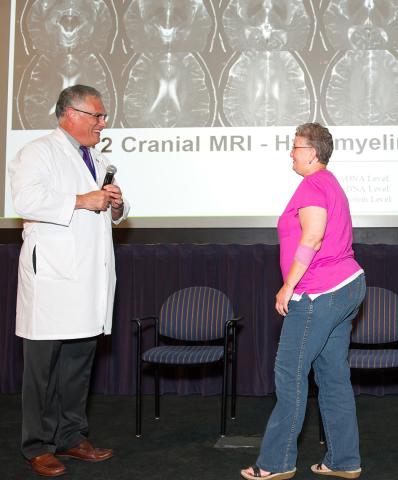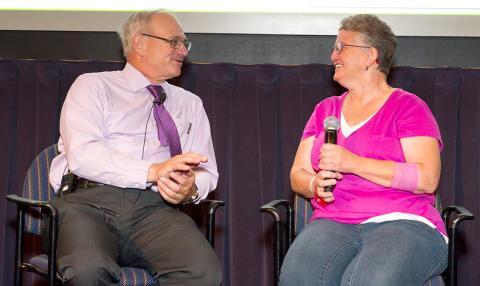Team Effort
Undiagnosed Diseases Program Seeks to Solve Medical Mysteries

Photo: Marleen Van Den Neste
When patients can’t get a diagnosis, they turn to Dr. William Gahl, head of the Undiagnosed Diseases Program (UDP) and clinical director at NHGRI.
“Our goal is to lend a hand to these individuals who don’t have a diagnosis to go on. A diagnosis is often a precursor to treatment,” said Gahl during an Aug. 3 lecture for summer students titled “The NIH Undiagnosed Diseases Program and Network: Diagnosis and Discovery” in Lipsett Amphitheater.
Started in 2008, the program, he explained, “helps patients reach a diagnosis when they didn’t have a diagnosis” and “offers some insight to the biomedical research community into medicine, namely cell biology, biochemistry and physiology.”
Program applicants must submit medical records along with a letter from a referring doctor. Once an application is received, the UDP consults with medical specialists within NIH to determine whether it would be a good case to take on. The program accepts roughly 30 percent of applicants.
Those admitted visit the Clinical Center for one week, where they undergo extensive testing, generally including exome or genome sequencing. Genomic sequencing determines the complete DNA sequence while exome testing determines the 1-2 percent of the genome that contains protein-coding genes. Often, family members provide blood and tissue samples. This approach allows researchers to compare a patient’s genome with those of the healthy relatives.
“In a week, we can get testing that would often take a year or two, going back and forth as an outpatient and getting permission from insurance companies,” Gahl said.

Photo: Marleen Van Den Neste
Over the past 9 years, the program has evaluated more than 4,000 medical records and seen more than 1,000 patients. Forty percent of patients are children and 50 percent of cases are neurologic. “We’ve made a diagnosis in about 30 percent of cases,” Gahl said. Doctors in the UDP make about half of their diagnoses because they recognize other rare diseases already described in the medical literature.
“When you make a diagnosis, you bring some measure of closure to patients who are basically questioned by their family, relatives, colleagues and, sometimes, their physicians, about whether they actually have something significant because they can’t name it,” he said.
Kathleen R. Kelley, a mother of one patient in the program, , was diagnosed with multiple sclerosis (MS) in 2000. She experienced headaches, walking difficulties and other symptoms. She began taking medicine to treat the condition. It turned out, however, she didn’t have MS.

Photo: Marleen Van Den Neste
She now believes she has the same condition as her daughter: oculodentodigital dysplasia, a rare disease that affects the eyes, teeth and hands. Symptoms include eye problems that may lead to vision loss, muscle spasms in the hands, dental problems and webbed fingers.
“It’s a calming feeling to know exactly what it is now. It’s not MS, so I don’t have to take that medicine,” she said.
Dr. Camilo Toro, a neurologist with the UDP, said the cost of MS drugs is “exorbitant.” Although many of the drugs are at least 20 years old, their prices keep rising. The medications cost around $50,000-$60,000 per year.
Even if there’s no treatment, getting the correct genetic diagnosis is extremely important. Patients who know what they have can inform their spouses for family planning purposes and can avoid medications that might make symptoms worse. When there’s a mistaken diagnosis, “harm can be done,” Gahl said.
Recently, NIH, via the Common Fund, launched the Undiagnosed Diseases Network, which encompasses 7 clinical sites around the country, a coordinating center and core facilities. So far, Gahl said, the network has received 1,500 applications. Of those, 400 patients have been evaluated and more than 100 have been diagnosed. The sites in the network can share patients’ personal information, including names.
“The patients allow that and actually want that, so they can find other cases and make a community of patients who have these rare, rare diseases,” Gahl noted.
